Interview: P&G’s SVP North America Home Care Talks 2030 Sustainability Ambitions


This article is sponsored by P&G
The mounting, intertwined impacts of climate change, pollution, biodiversity loss, and global poverty are challenging companies to continue to improve on issues of sustainability and social impact. The question facing many large companies is how, and by how much, they can continue to build upon their successes thus far, and their ambitions for the future. Proctor & Gamble, having achieved or surpassed many of the goals it wanted to achieve by 2020, has set new, more ambitious targets to reach by 2030.
Next on P&G’s agenda is Ambition 2030, a set of goals that includes purchasing 100 percent renewable electricity globally, cutting greenhouse gas emissions in half at P&G sites, boosting water efficiency by 35 percent, encouraging more recycling to keep P&G packaging from reaching the oceans, and several other targets related to sustainability and reducing carbon footprint. P&G also says it is integrating social and environmental sustainability as a key strategy in its global businesses, investing in educating employees about sustainability, and linking executive pay to progress in meeting environmental, social and governance (ESG) goals.
TriplePundit recently spoke with Marchoe Northern, senior vice president for North America Home Care at P&G, to find out more about how she’s bringing P&G’s Ambition 2030 to life on her business.
TriplePundit: P&G is looking to respond to challenges such as global poverty, climate change, pollution and biodiversity loss through the Ambition 2030 strategy. Can you tell us a bit more about Ambition 2030 and how it influences the way P&G Home Care brands like Cascade and Dawn do business?
Marchoe Northern: Ambition 2030 is a set of broad-reaching goals aimed at enabling and inspiring positive impact for the planet while creating value for the company and consumers. It is the next step in our sustainability journey after achieving many of our 2020 goals and includes science-based targets that help pace our progress toward becoming net-zero by 2040. We will accelerate our use of renewable energy, advance technologies to decarbonize our supply chain, and invest in water accessibility to protect water for people and nature. Further, we will reduce our use of virgin petroleum plastic in packaging by 50 percent, and 100 percent of our consumer packaging will be recyclable or reusable by 2040.
If we have learned anything from the IPCC (Intergovernmental Panel on Climate Change) and other climate change research institutions, it’s that this decade is crucial to safeguarding a healthy planet for the future. We know we don’t have all the answers, and that it will take partnerships and collaboration to make meaningful progress and reimagine responsible consumption.
3p: How do P&G Home Care brands look to engage their key stakeholders — such as employees, suppliers and customers — in their sustainability work?
MN: An example of how we’re engaging stakeholders, suppliers and customers is through the launch of Dawn Powerwash — a product that employs recycled plastic, a refillable format, and spray activated suds that eliminate the need to pre-rinse or soak dishes. We can thank our R&D teams for the formula that saves up to 81 gallons of water per week for typical household dishwashing needs. We can thank partners like the Alliance to End Plastic Waste and PureCycle Technologies for creating new recycling streams and driving toward more consumer-friendly, circular solutions like the Powerwash refill format.
What’s great is that so many of our employees, like myself, are passionate about sustainability and are looking to connect innovation from one product portfolio to another. As a parent, I want the world to be a better place for my children, and I’ve heard that from our product designers, too; they want to design more sustainable products. It’s the same thing in talking with our partners and retailers; they want to help educate consumers, whether online, on-shelf or otherwise. Consumers also share they want to live more sustainably. We’ve seen a collective mindset shift toward sustainability among all our stakeholders, so it’s now about creating products and programs that meaningfully engage everyone in this ecosystem.
3p: What do you feel are some of the biggest accomplishments P&G Home Care brands have made in alignment with Ambition 2030 so far?
MN: I love the strides we’ve made in packaging. We recently overhauled our Swiffer package design for duster products that eliminated plastic packaging, effectively reducing plastic usage by 173 tons per year, as much weight as 122 Honda Accords.
Mr. Clean Magic Eraser recently switched from a polyethylene terephthalate (PET) tub design to one that uses recyclable carton boards. That innovation reduced our plastic usage by 482 tons per year. We’re making strides in our Dawn and Febreze portfolios. In addition to a formula that reduces water usage by up to 50 percent, Dawn Powerwash features a reusable trigger and recyclable refill, and we’ve done a lot of work to reduce our reliance of virgin plastic with Febreze, currently using 25 to 50 percent post-consumer recycled content (PCR) within the portfolio. By innovating individual Febreze product lines, such as completely eliminating plastic thermoform PET blisters from our Plug refill packaging, we’ll save an estimated 175 million pounds of plastic across the entire portfolio by 2030.
3p: What are some of the most powerful partnerships to come out of the strategy? What do you feel other business leaders can learn from them about establishing relationships that drive positive impact?
MN: We know we need to be clear-headed about our own capabilities and gaps, and we need partners to help with the pieces we can’t do on our own. One of the most powerful examples of this is our partnership between Cascade, a household brand helping millions of people reduce their daily water footprint, and the Bonneville Environmental Foundation’s Change the Course campaign, a water conservation initiative to restore and protect water at the source.
The partnership consists of a project portfolio that will restore more than 2.6 billion gallons of water to rivers and wetlands across the United States in some of our most water-stressed regions. Cascade and Change the Course work together on water stewardship education, while Cascade supports critical funding of the project portfolio, and Change the Course manages local engagement, vetting on-the-ground projects, and working directly with communities.
3p: What can you tell us about the challenges P&G Home Care brands have faced on the journey toward Ambition 2030 and how they responded?
MN: What’s best for the planet usually isn’t easiest, fastest or cheapest. It’s often quite the opposite. We believe that sustainability shouldn’t compromise performance, and that perspective helps us innovate. When we land on those new innovations that make sustainability irresistible, it makes the positive impact even more satisfying.
Another challenge is how we partner with consumers when the product’s use presents a big opportunity to improve carbon impact, like with our Dawn and Cascade brands. Designing the products to work with less water and energy is only part of the equation. We need people to skip the pre-rinse or pre-soak, which isn’t necessary with the right product formula. People who use our products should know we won’t make them choose between sustainability and a safe, superior clean.
3p: Based on what P&G Home Care brands have learned on their sustainability journey so far, what advice would you give to business leaders looking to scale up sustainability efforts at their companies?
MN: Understand that being ambitious and realistic aren’t mutually exclusive. Set big goals but hold yourself to incremental progress. Rome wasn’t built in a day, but it was built.
Find partners that have the same end-goal but have different capabilities and viewpoints. Be honest about your strengths and do the same for your partners. Our recycling partners have capabilities that we don’t, but both of us ultimately want consumers to recycle more. Our wildlife partners like International Bird Rescue and the Marine Mammal Center have the personnel and conservation expertise that allow us to collectively support ecosystems and protect biodiversity. There is strength in numbers, so look for like-minded partners that you can work with to achieve collective goals.
Lastly, keep your focus on the people you’re serving. When it comes to sustainability we should think about what our companies can do, but we should also think about what we can enable others to do. Take dishwashing, for example. Combining research that shows consumers want to be more sustainable with lifecycle assessments that show 80 percent of dishwashing’s carbon impact occurs during consumer use leads to innovations like Dawn Powerwash.
Consumer behavior matters and that’s where marketing and communications are critical. Letting consumers know that you’re creating products and services that not only make their lives easier but enable them to create more sustainable habits are key to scaling sustainable impact.
This article is sponsored by P&G.
Image credit: Tyler Casey via Unsplash
The NBA Needs to Go Further on GOTV for the Midterm Elections


Professional sports organizations have been getting more involved in get-out-the-vote (GOTV) efforts, and the NBA appeared to raise the bar last week, when it announced that it would schedule no games on Election Day. However, the league and its teams still need to decide whether or not to choose a side, even as one of the two major political parties in the U.S. continues its pell-mell lurch into dangerous extremism.
Drawing attention to the midterm elections is an important step
The NBA won the media spotlight last Tuesday, when it tweeted out its intentions for Election Day 2022. In the tweet, the league clarified that it is picking no sides. It is simply encouraging the individual teams to “promote civic engagement in their respective markets.”
“The NBA today announced that no games will be played on Election Day, Tuesday, Nov. 8, 2022,” the league stated, emphasizing that “the scheduling decision came out of the NBA family’s focus on promoting nonpartisan civic engagement and encouraging fans to make a plan to vote during the midterm elections.”
AP reporter Tim Reynolds points out that at least two other major league sports teams have scheduled no games on Election Day for decades, without drawing any media attention at all: Major League Baseball always ends its schedule before Election Day, and the National Football League has only played a handful of games on a Tuesday since the 1940s.
Editor's note: Be sure to subscribe to our Brands Taking Stands newsletter, which comes out every Wednesday.
Still, the NBA announcement raises the profile of the midterm elections, and that could be a game-changer in terms of voter turnout.
Both voter motivation and media attention fall dramatically during the midterm election cycle, compared to presidential election years. According to a 2017 study published by Pew Research Center, midterm voters tend to be those who are engaged politically on a consistent basis, not just every four years.
The “drop-off” phenomenon is especially acute among younger, non-white and less economically advantaged voters. That demographic divide means that the midterm electorate skews toward a highly motivated demographic that tends to vote Republican: white, older, and relatively affluent.
Voting rights and the midterm drop-off phenomenon
All else being equal, the midterm drop-off would not necessarily have an impact on the political balance in Congress. However, back in 2010 several Republican-led state legislatures exacerbated the demographic skew, when they engineered a round of gerrymandering aimed at diluting the ability of Democratic candidates to win seats in the U.S. House of Representatives.
In 2013 a majority decision by the Republican-appointed justices on the U.S. Supreme Court also impacted the demographic divide when they threw key parts of the 1965 Voting Rights Act. That cleared the way for states to enact new voting restrictions, many of which repress the ability of Democratic candidates to win seats in the U.S. Senate and other statewide races.
The 2013 Supreme Court decision continues to ripple out in powerful waves to this day. It provided former President Trump and his allies with more leverage to argue for even tighter restrictions during the 2020 election cycle, under the guise of false allegations about voter fraud.
Trump and his allies doubled down on voter fraud even more during the 2020 cycle, thus setting the stage for the insurrection of January 6, 2021.
The insurrection did not end on January 6, 2021
Last year’s bloody attack on the U.S. Capitol failed to reverse the results of the 2020 election, but the threat of violence never stopped. The insurrectionists simply changed strategies, as well as Trump and his allies. After the mob was turned away on January 6, 2021, the points of attack began to diffuse across election offices throughout the nation.
Within a few months, the growing threat of violence against election officials and workers spurred the U.S. Department of Justice (DOJ) to establish a task force to address the problem on a national basis.
The task force launched in July of 2021. Earlier this month DOJ provided an update on its activities during a virtual meeting with hundreds of election officials and workers.
Since July 2021, DOJ has investigated 1,000 threats to election officials and workers. Verbal threats often do not rise to the level of a crime, but the agency did determine that approximately 11 percent of the contacts met the threshold for a federal criminal investigation.
DOJ also uncovered a connection between threats of violence and the series of lawsuits and mismanaged recounts that muddied the electoral waters in closely contested states after the 2020 election.
“Election officials in states with close elections and post-election contests were more likely to receive threats. 58 percent of the total of potentially criminal threats were in states that underwent 2020 post-election lawsuits, recounts, and audits, such as Arizona, Georgia, Colorado, Michigan, Pennsylvania, Nevada, and Wisconsin,” DOJ explained.
So, what exactly can the NBA do?
Against this backdrop, the NBA’s emphasis on nonpartisan politics is weak tea indeed.
A key element in the Republican playbook is to undermine any nonpartisan institution that promotes independent thinking. That includes any organization with deep roots in the civic landscape, including the Girl Scouts of America, public schools and universities, and, increasingly, professional sports leagues.
The extremism has already proved too much for the League of Women Voters, an organization that was formerly notorious for its militantly hands-off approach to partisan politics.
In an article published last week, the independent news organization ProPublica noted that “…two days after the Jan. 6, 2021, attack on the Capitol, the league’s board of directors called then-President Donald Trump a “tyrannical despot” and blamed him for inciting the violence and for threatening democracy. The league demanded his removal from office ‘via any legal means.’”
If the NBA expects an expression of nonpartisanship to protect it from accusations of political bias, that ship sailed back in 2020 after the league embraced the Black Lives Matter movement.
The voter fraud canard is nothing more than white supremacy written into law, and it is just one part of an all-encompassing drift into undemocratic extremism. The Republican Party and its media allies have embraced hardcore anti-women and anti-LGBTQ policies, terrorized trans youth, their families and care providers, and promoted book bans and educational censorship among other acts of repression that undermine the mainstream of democratic progress in the U.S.
How to not drop the GOTV ball
The NBA still has an opportunity to advocate for candidates who support human rights, civil rights and the rule of law.
For example, the NBA announcement makes it clear that each team is free to exercise its GOTV initiatives as it sees fit, and to share voting resources from its partners.
That can pack a powerful punch. During the 2020 election cycle, the NBA and WNBA both partnered with The Civic Alliance, the NAACP Legal Defense Fund, Power the Polls, Rock the Vote and other organizations.
The NBA can also help make election workers and other stakeholders aware that the DOJ is encouraging members of the public to report threats to its confidential tip line, 1-800-CALL-FBI (225-5324), or file a complaint online at tips.fbi.gov.
The Brennan Center for Justice is another potential resource for such collaboration. Earlier this month the organization published an assessment of election misinformation, including guidance for ensuring that voters are not misled.
If the Republican party persists in fielding candidates for office who fail to meet simple, basic standards of human rights and civil rights in a modern democracy, that’s on them. The NBA is not obligated to pretend that Republican candidates are capable of governing responsibly, nor is any other business organization in the U.S.
Image credit: Marius Christensen via Unsplash
Ford Beats One of Its Own Goals in Race to Be Carbon-free by 2050 — But Is It Enough?
Jim Farley, Ford Motor Co's president and CEO, talks with UAW Workers Deano Felix and Cheryl Williams at the company's Michigan Assembly Plant Modification Center in Wayne, Michigan, following an event to commemorate the next step in the company’s sustainability plan. (Image courtesy Ford)
Ford Motor Company and DTE Energy are working together to bring an additional 650 megawatts of solar energy to Michigan by 2025 — at which point the automaker says it will no longer need to use electricity produced from carbon-emitting sources to assemble vehicles in the state. In doing so, Ford has cemented its dedication to transitioning to cleaner energy not just to power its products, but to manufacture them as well. While this may be considered a bold move for a legacy carmaker, it’s actually a smart financial choice in line with younger buyers’ brand expectations.
The clean energy agreement will increase the state of Michigan’s total solar energy output by 70 percent and prevent 600,000 tons of carbon dioxide emissions each year. As a comparison, the average passenger car emits 4.6 metric tons of C02 annually, so that’s the equivalent of just over 130,000 ICE vehicles coming off the road. This is the largest solar purchase in the history of the U.S. and will lead to 250 temporary jobs and 10 permanent ones.
The transition to clean energy in Michigan will beat Ford’s original goal by ten years, which bodes well for the automaker’s plan to be entirely carbon neutral by 2050. To get there, Ford plans to pour $5 billion into electric vehicles this year alone, with $50 billion total set to be expended by 2026.
Doing so may be a matter of doing the right thing for the planet, but it’s also a matter of the brand’s survival. Younger buyers — and specifically Gen Z — expect businesses to put their money where their mouth is. So, it behooves legacy automakers to not just go after Tesla’s 70 percent market share, but to be more environmentally responsible than the all-electric manufacturer in the process.
As their addiction to fast fashion has shown, Gen Z doesn’t expect perfection and there are plenty of situations where they will let sins against the climate slide. Still, the auto industry shouldn’t expect the same free pass as apparel brands like Shein and H&M. People have to wear clothes after all. But younger people are increasingly questioning whether that same imperative still applies to owning automobiles. In fact, 31 percent of Gen Z and millennial survey respondents said they didn’t think kids growing up today would ever need to drive a car.
The industry is changing — and not just in the internal combustion versus charging station sense. With potentially fewer consumers interested in passenger vehicles as status symbols, and many seeing them as unnecessary property, automakers should consider preparing for the de-growth of their primary product.
While it may sound dire, de-growth is an opportunity to put purpose ahead of profit. It’s also an opportunity for manufacturers to evolve beyond single-owner automobiles, with which Ford has been flirting— the brand best-known for its oversized, gas-guzzling trucks partnered with Motivate back in 2017 to launch bike sharing in the San Francisco Bay Area. It also built a micro-mobility subsidiary dedicated to e-scooters but sold it off earlier this year to a European competitor, Tier.
By focusing on access instead of ownership, legacy carmakers may have a better shot at remaining relevant. And while micro-mobility and carsharing remain risky investments, it may be riskier still for brands not to take a chance on innovation.
Of course, just because younger consumers appear to be shifting away from individual ownership and towards public transportation, biking, rideshare and carshare doesn’t mean that the demand for new cars will completely dry up. Indeed, new passenger vehicles will still be necessary for ridesharing and carsharing purposes as well as for a shrinking demographic of personal users. In that sense, Ford is ahead of the game as it transitions to carbon-free electricity in Michigan.
Image credit: Ford Motor Co. media relations
Why It Isn’t ‘Radical’ for Companies to Take a Weeklong Break


Last summer, the social impact NGO New Profit shut its doors — physical and virtual — for several days around the Labor Day weekend for what it described as a much needed “period of collective rest.”
Reactions came from all directions, including memes that appeared on New Profit’s social feeds after the organization announced that the entire team “will be stepping away from the inbox, turning off the webcam, and closing the laptop.”
After discussions over why a break was needed, what everyone’s out-of-office replies would say and how to manage anything urgent during the seven business days New Profit would stay off the grid, the organization settled on having two emergency contact numbers: the cell phone numbers of its two CEOs.
An incredible thing happened — not a single call came in.
Why shutting down for a few days can benefit everyone
One year later, New Profit is taking another “radical” break at the end of the month. The nonprofit’s experience with shutting down for a week offers a strategy that any company, of any size, in any industry should consider.
According to New Profit’s co-CEO Tulaine Montgomery, last year’s shutdown was necessary as the previous 18 months, which of course coincided with the global pandemic, had presented a huge challenge for many of the organization’s employees — a sentiment with which just about any worker in any sector could agree.
Editor's note: Be sure to subscribe to our Brands Taking Stands newsletter, which comes out every Wednesday.
Naturally, a surge in media coverage about companies temporarily “shutting down” made waves, along with a discuss over the pros and cons surrounding such a decision. Companies such as Bumble and LinkedIn and most recently, Nike, took similar organization-wide breaks, usually with the reason being to address and prevent employees from burning out.
For Montgomery, however, New Profit’s decision was about going beyond self-care, well-being or burnout:
“It’s one thing to agree that rest is important, particularly on social media where it is often framed as a dimension of self-care. It’s an entirely different thing to build a culture that centers rest, framing it as a dimension of community care, and making it available to everyone — from the people who keep the lights and servers on and the payroll running while everyone else’s screens go dark, to the workers in retail, restaurants, manufacturing, construction, and other industries that find it harder to hit pause.”
Montgomery’s perspective on why such a reset is crucial applies to all companies across all sectors. And while it may be unrealistic for a massive international company to go dark for a week, there’s a case to be made to rotate a week off, with no strings attached, across any organization so that people can take a physical, intellectual and emotional break from the daily grind. In the case of LinkedIn, a core team remained on the job to ensure the lights stayed on and the platform functioned, but those employees were able to take time off later in the year.
In Montgomery’s words, “We have to give ourselves time to rest, and model it and push for it in our communities, so we can help build a culture that normalizes conditions that enable us humans to be at our best.”
Why employees occasionally need a complete break
One reason why employees need time to rest, reflect and recharge is akin to one long-established conclusion: Some of the most creative ideas have emerged from, of all places, the shower. Why does such inspiration occur during such a counterintuitive time and ritual? Well, our brains can only manage so much at once. The ways in which our brains are wired are not a matter of one’s level of intelligence or competence, but of science.
To that end, while Montgomery and her peers at New Profit may explain that taking those seven business days off is “radical,” in the long term such a move really isn’t risky at all. Innovation is important for any company’s continued success, but such transformation cannot occur organically if everyone feels harried and overwhelmed. However, allowing a company’s collective brains to recharge, reboot and reset could pay dividends that are way more rewarding than a forced brainstorming session in a stuffy meeting room and a whiteboard.
So give your employees a much-needed week to decompress. It’s good for their brains, their souls and, pragmatically, can help a company thrive with new, bold ideas.
Image credit: Luis Villasmil via Unsplash
U.N. Report Highlights Widespread Modern Slavery in China


A father with his child in Xinjiang, China
A new report from the United Nations Special Rapporteur has found widespread evidence of state-sanctioned modern slavery in Tibet and Xinjiang, China, homeland of the Tibetans and Uyghurs.
According to the report, such “work is involuntary and workers are subject to excessive surveillance, abusive living and working conditions, restricted movements, threats, physical or sexual violence, and other inhuman or degrading treatment.”
Calling out modern slavery — finally
The report is significant because, thus far, the U.N. has been mostly silent on what’s happening in China, under the increasingly nationalistic single-party rule led by strongman Xi Jinping. This is despite evidence, for years now, that the Chinese government has been detaining upwards of a million Uyghurs in forced labor camps. For example, the outgoing High Commissioner for Human Rights, Michelle Bachelet, has yet to release her long-awaited report on the situation. This report might be a sign that things are changing.
“The case against the Chinese government at the U.N. level continues to build,” said Omer Kanat executive director of the Uyghur Human Rights Project, a Washington, D.C.-based nonprofit. “It should now be impossible for U.N. agencies and member states to ignore atrocities of this magnitude.”
Since 2017, the situation in the Uyghur homeland in eastern China has deteriorated significantly. What started out as a digitally enhanced police state morphed into what has been called the largest system of concentration camps since World War II, housing perhaps as many as 3 million Uyghurs and other mostly Muslim minorities. Mosques, Uyghur neighborhoods and shrines have been destroyed, and the use of their language is increasingly prohibited.
Meanwhile, in Tibet, a colonial style-boarding school system has been set up, forcing as many as 800,000 Tibetans away from their parents and into schools where they’re forced to learn Mandarin Chinese and forbidden from speaking Tibetan or from celebrating traditional Buddhist holidays. It’s reminiscent of tactics used in the U.S. and Canada to forcibly assimilate Native Americans.
“The Chinese authorities are using one of the most heinous tools of colonization to attack Tibetan identity,” said Lhadon Tethong, director of Tibet Action Institute, in a press statement. “China’s unprecedented campaign of forced sinicization in Tibet targets even the youngest children and demands urgent intervention.”
Sadly, because of China’s economic power, political action on modern slavery has been lagging, particularly at the international level. It does not help that China has severely restricted access to both Tibet and the entire Uyghur homeland — a situation made worse by China’s strict zero-COVID border control policies — making it hard for journalists and civil society to really gauge the extent of what is happening.
Multinationals need to take a stand on modern slavery
Unfortunately, there’s another group that’s been even slower to act than the U.N. on modern slavery — multinational companies, many of which have supply chains that reach deep into China and, as numerous media, civil society and labor investigations have shown over the past several years, dozens of these companies have been implicated in Uyghur forced labor, Tibetan environmental degradation or ongoing labor rights abuses.
“Forced labor programs have been weaponized [as] a tool of genocide by the Chinese Communist Party — and yet corporations around the world continue to turn a profit from atrocity,” said the president of the World Uyghur Congress, Dolkun Isa, in a statement. “This report’s findings must be a wakeup call to those that have so far refused to take action on the proliferation of Uyghur forced labor made goods in global supply chains.”
China is the main trading partner for the majority of countries in the world, and it is the leading source of imports into the United States and much of Europe. Many of the goods are connected to Xinjiang and Tibet. A report from C4ADS identified high-risk commodities that were still being imported into the U.S. despite potential links to Uyghur forced labor.
Now, inaction will have a clear cost. The passage and coming into force of the Uyghur Forced Labor Prevention Act in June of this year, the first law in the world that specifically targets the Chinese government’s use of forced labor, is already having an impact on the flow of goods from China to the U.S.
While cotton and garments have gotten the most attention, the C4ADS report also identified poly-silicon (used in solar manufacturing), pepper, tomatoes, beryllium, rayon, wind turbines and calcium carbide. Meanwhile Tibet is a key source of minerals used in technology supply chains — often mined on land stolen from Tibetans.
Inaction comes at a high price
There’s a cost to inaction on modern slavery, primarily due to the recent coming into force of the Uyghur Forced Labor Prevention Act this past July. It was passed with bipartisan support partly as a response to the failure of brands to act independent. Already, this legislation has led to the U.S. blocking numerous shipments of solar photovoltaics — an industry that China dominates and has clear links to the Uyghur homeland. The U.S. is unlikely to hit its goals for solar installations this year, which will harm the country’s climate goals.
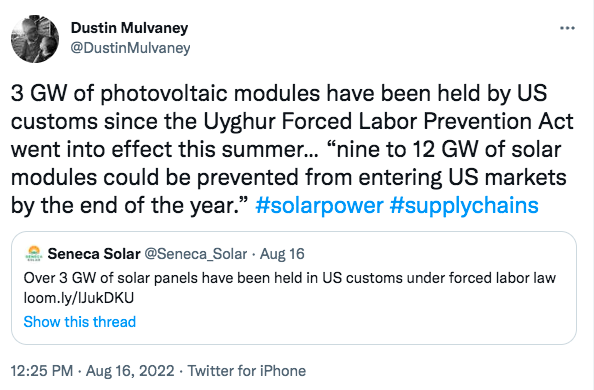
It is hard to have much sympathy for the solar industry when groups like the Solar Energy Industries Association have been warning members about the extent of Uyghur forced labor in solar supply chains since 2020. Nor for others who, soon, may also see their imports blocked. We’ve known about the human rights atrocities since 2008, when the first crackdown of protesters in Tibet took place, and news about the Uyghur camps first broke in 2018. The failure is of businesses to act promptly and live up to their promises, stated again and again in yearly corporate responsibility reports and due diligence statements, about their commitments to ethical sourcing.
There were exceptions. Patagonia made plans to exit the Uyghur region once it found out about the human rights abuses, and it now sources cotton from other regions. Had more businesses been like Patagonia, perhaps we wouldn’t be facing a solar shortage right after the passage of a critically important climate bill. But more importantly, perhaps the Chinese government would have felt actual pressure to change its repressive policies toward Tibetans and Uyghurs.
Image credit: simon sun via Unsplash
In Post-Roe America, Companies Must Show, Not Tell, That They Value Employee Health
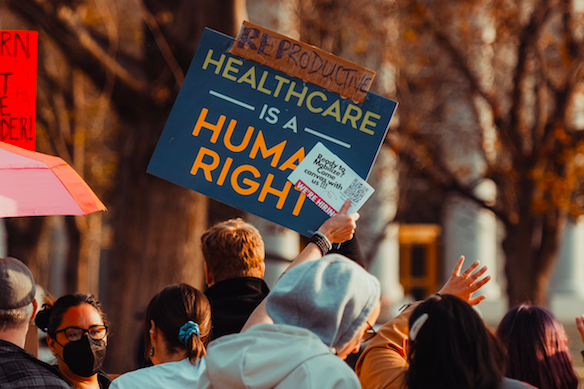
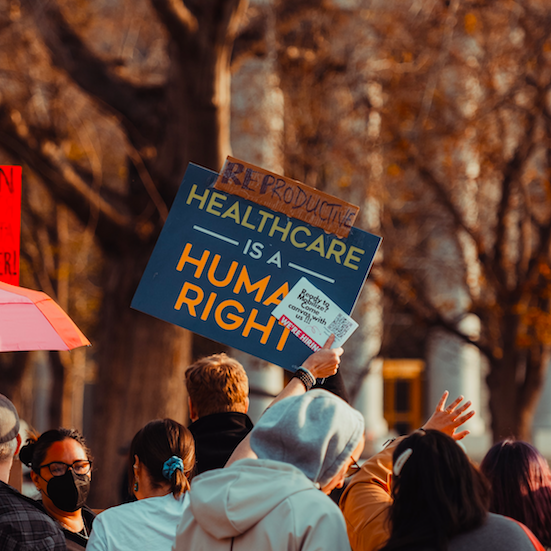
A protest in support of reproductive rights in Denver, Colorado, May 2022
In the past few years, corporations have increasingly become involved in issues of social justice, be it through Pride Month-friendly advertising or monetary pledges to racial justice organizations in response to the 2020 resurgence of the Black Lives Matter movement.
All’s quiet in a post-Roe U.S.
Yet almost two months after the Supreme Court overturned Roe v. Wade and shook the foundations of the right to reproductive health services for hundreds of millions of Americans, corporations have been far more reluctant to take a public stand either in support or protest of the Supreme Court’s decision.
Employees should not construe this apparent corporate silence, however, as indicative of a company’s support of the overturning of Roe. Likewise, employees ought not mistake corporate statements condemning the Supreme Court’s decision as a pledge to protect and maintain employee health.
Dr. Yuvay Ferguson, the assistant dean of impact and engagement, as well as an associate professor of marketing at Howard University, said companies that are doing the right thing don’t need to broadcast. By and large, if a corporation prioritizes the health of its employees, it will have already fostered a culture that expresses more support than any press release or company-wide message could convey.
A true commitment to employee health means a company doesn’t have to be performative
“You don't have to necessarily be performative if you have people in the room that can really speak to how others are experiencing the world around them,” Dr. Ferguson said, emphasizing that proper employee health care extends beyond a corporation’s benefits package. “There's such a bigger picture about what a person that may be disenfranchised, or a minority in that setting, would want and hope to experience.”
Dr. Ferguson says there aren’t any companies that have stood out as exceptionally vocal one way or the other after the decision. There’s no point to vocalize a stance on such a polarizing issue, because either way you only stand to alienate employees, customers, investors and potential partners.
Some companies, like Starbucks, have announced an intention to pay for employees’ travel fees to seek an out-of-state abortion or gender-confirming surgery — but this offer only exists for employees who have signed up for the corporation’s health care plan. As more and more Starbucks employees look to unionize, the company could not guarantee that union employees would be eligible for the full benefits of the health care plan.
Employees are now in a post-Roe legal quandary
It’s easy for a multimillion-dollar corporation to fly someone to another state, but what if the employee’s home state retaliates in a post-Roe America?
Given the tenacity of the Texas state government’s abortion legislation — including a bill that encourages citizens to sue the recipients and providers of abortions — it is not hard to imagine a situation in which a low-level employee faces the brunt of retaliatory harassment from state lawmakers frustrated with a citizen evading state jurisdiction.
And while corporations have the sufficient legal power to battle it out with a state government, it is difficult to imagine a corporation actually supporting an employee through a subsequent legal battle against state legislators in this post-Roe environment.
“At least on paper, no company is going to signal in any way, shape or form to its female employees that they would support a legal battle over an abortion,” Dr. Ferguson said.
Speaking of Texas laws, Dr. Ferguson mentioned the case of a pregnant woman in Texas who was ticketed for driving in the carpool lane, arguing that, by Texas’s own standards, she and her fetus constituted two passengers, qualifying her to drive in the carpool lane. Dr. Ferguson believes she is being financially backed by some higher power, but almost certainly not her employer.
No one’s leading the charge for abortion rights, yet — at least not loudly — but that doesn’t mean that companies aren’t scheming up ways to fight the long game.
Dr. Ferguson pointed to Disney’s recent battle with the state of Florida and its “Don’t Say Gay” legislation, and expects other corporations to find ways to financially punish anti-abortion states, such as by relocating facilities to pro-choice states.
So, employees should not read too deeply into the apparent lack of public reactions from companies. Corporate silence in reaction to the Supreme Court’s decision is preferable to self-promoting volume. After all, empty corporate messaging is performative at best and almost cynically exploitative at worst. Furthermore, the attention on abortion shouldn’t obscure other facets of a safe healthcare plan.
“It shouldn't just be because the world is looking at abortion, that we only talk about abortion,” Dr. Ferguson said. “So, having reproductive health benefits are super important — things like maybe adoption, or infertility or fertility treatments, or birth control.”
Employee research groups, Dr. Ferguson said, can help corporations develop cultural fluency to improve employee health benefits.
Actions speak louder than words in a post-Roe world, and corporations must strive to create and maintain an environment in which employees feel protected, supported, prioritized and valued.
Image credit: Colin Lloyd via Unsplash
Now is the Time for Businesses to Claim Inflation Reduction Act Incentives and Take on Climate Change


Last week U.S. President Joe Biden signed the Inflation Reduction Act (IRA) into law. The bill is already being hailed by some as the most important action the United States government has taken toward climate change mitigation, although some economists question the legislation’s immediate impact on inflation. According to a White House brief, some of the biggest benefits are expected to come in the form of lower healthcare and prescription drug costs, more affordable clean energy development for consumers and businesses, and a reduction in the nation’s deficit.
The IRA offers many opportunities to companies taking on climate change
“You have to shake the tree to get the plum,” Thomas Peterson, CEO of The Center for Climate Strategies, said in a briefing about the recent legislation held by the American Sustainable Business Network last week. He’s speaking to the opportunities this legislation opens to businesses, including a lot of money. The bill invests $369 billion toward energy security and climate change, according to a summary published by Senate Democrats.
Peterson has been involved in climate legislation from the time of the Kyoto Protocol, at one point acting as senior advisor to the White House Climate Change Task Force. He said he’s seen a lot of progress since that landmark moment. While the Kyoto Protocol took a more top-down approach, Peterson noted that the Paris Agreement now has a more grassroots take on progress.
The only issue with the Paris Agreement, Peterson said, is that it doesn’t self-implement. It simply doesn’t provide funds to do so. Even so, Peterson calls the Paris Agreement the biggest policy development for climate in the last 27 years. What’s more? He places the IRA right under the Paris Agreement as its “kissing cousin” in significance. Basically, the U.S. is finally putting its money where its mouth is — and the country’s climate goals need a lot of money, he emphasized. After all, by 2030 the U.S. plans to reduce its net greenhouse gas emissions by around half. By 2050, the nation aspires to reach net-zero emissions.
Businesses need to start scaling up their investments in clean energy and transportation
The general intention that Peterson sees behind the IRA is to enable the private sector to step in and do its part to tackle climate change. Businesses need to be proactive, he said, especially since the public sector can’t finance the majority of the work that needs to be done to reach our climate goals. “We’re really talking about mobilizing funds at an astonishing scale,” Peterson added.
A couple of the opportunities Peterson mentioned as worth exploring are the clean energy tax credits, which are also applicable to tax-exempt entities, and the first-of-its-kind national clean energy business accelerator called the Greenhouse Gas Reduction Fund (GGRF). The Fund can allocate up to $27 billion for clean energy technology development.
One small business expert, Rhonda Abrams, outlines for USA Today the myriad tax credits available under the bill, including hefty credits for commercial electric vehicles. For vehicles over 14,000 pounds, those credits can reach $40,000. Abrams adds that this stimulus to the clean energy economy will also have incidental benefits for small businesses: "Small businesses will see demand for their services and products increase as a result of this legislation,” she writes. “Homeowners who convert to energy-efficient home energy products — like new HVAC systems or heat pumps — almost always use a small business for the work.” The boost also extends to small manufacturers and suppliers, Abrams writes, since the bill includes mandates that support domestic manufacturing.
The results could be staggering. Senate Democrats estimate a 40 percent reduction in carbon emissions by 2030 and millions of new domestic manufacturing jobs in the clean energy sector.
But reaching that summit requires commitment from businesses. After all, incentives mean nothing if there’s no investment or purchase. It’s time to start shaking that plum tree.
Image credit: NASA via Unsplash
How to Engage with Co-Workers About Climate Change Challenges
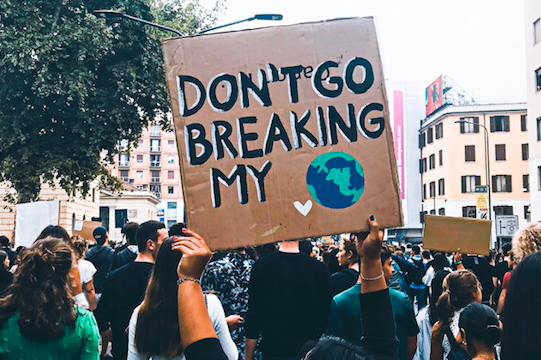
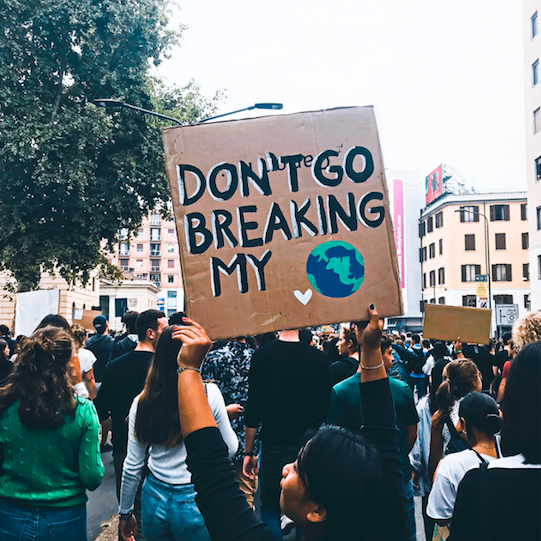
From scorching summers to devastating floods, it’s become impossible to ignore the impact of climate change. As a result, there has never been more desire from and demand by people around the world for countries to adopt more sustainable agendas. Companies, too, are now forced to reckon with the part that they play in climate change and develop environmentally-focused strategies.
Conversations about climate change often occur within the workplace, and it’s imperative that co-workers have conversations within their teams about common climate challenges and what their organizations can do to lessen their climate impact. These conversations help companies establish more environmentally-friendly habits from the ground up, habits that will benefit both the companies and the planet.
Why climate challenges matter to business
Climate change may have once been easy to put to the back of our minds, but no longer. And yet, it still feels that many business leaders are unaware of the direct impact climate change will have on their companies.
In 2019, the UN’s International Labor Organization (ILO) reported that productivity losses equivalent to 80 million full-time jobs will accrue by 2030 due to heat-related climate change. But that’s not the only concern. Many companies are woefully unprepared for the unpredictable impacts of climate change on supply chains, energy access, and, consequently, finance. Understanding what climate challenges mean to the future of your business can help prepare your company and your workforce for such changes.
Companies everywhere need to think more proactively about what they can do to decarbonize the way they conduct business. While decarbonization is a good thing, changes to business models and investing in sustainable measures to achieve this takes time and resources. Some employees may not be as responsive to systemic changes within their organizations—which is why conversations about the benefits of adopting sustainable practices are vital.
From an employee level, a 2021 report by IBM found that 71 percent of employees wanted to work for companies that are environmentally and socially responsible. This suggests that one of the main benefits of adopting more sustainable business practices is greater staff retention.
As a result of increased focus on environmental policies, we’re also noticing an uptick in the importance of corporate social responsibility (CSR).
This is a broad, self-regulating model that serves as building blocks that businesses can use to know that they’re doing well by the planet and their employees. CSR aims to benefit all sectors within a business by creating an expansive framework and workable targets that demonstrate progress toward better ways of working.
To ensure the success of any CSR initiative, companies must achieve employee buy-in to the conceptual goals and practical objectives of the program. And one of the best ways to do this is to promote and foster employee conversations about what the company can do to achieve its sustainability goals. This will not only promote a culture of change, but it will also yield practical steps the company can take that might not otherwise come to the fore.
Propagating talk on climate change
Discussing climate change among your team can be one of the most beneficial things that you do today. Peer-to-peer communication can be a lot more effective than one-way messaging from the top down. A recent survey by the Yale Program on Climate Change Communication found that 23 percent of people heard other people talking about the climate crisis at least once a month.
One larger benefit here is that internal conversations can propagate externally, leading employees to discuss climate change with their families and friends, which increases the wider acceptance of a commitment to counteract global warming.
It’s important to approach climate change conversations in a way that mitigates panic or frustration among employees. Rather than harping on the worldwide environmental distress that climate change is causing, highlight the potential benefits of adjusting your company’s business model. Try adopting a solutions-based approach, with meetings that focus on specific, strategic initiatives. There’s no need to negate or belittle the company’s current business model. Instead, focus on developing practical solutions with concrete, achievable results.
How can your company fight climate change?
Another key to a successful CSR is transparency. Being transparent about climate-friendly procedures can help companies develop, manage and amend their internal policies. Only when the company is fully open about its climate impact can it truly reap the rewards of setting about to neutralize that impact. Transparency helps an entire team develop a unified strategy for achieving meaningful changes.
Most important, the company needs to act. But the steps that a company takes to address climate change don’t have to be grand and sweeping. There are numerous ways that a company can start making its commitment to change visible, one small step at a time. For instance, something that might seem too insignificant to adopt like a monthly public transportation allowance for employees could get you on the right track. You can provide reusable dishware and utensils to replace disposable ones. You can also offer work-from-home options to reduce the size of the office and thus energy usage.
Of course, companies need to do much more than just offer visible, internal signs of its CSR commitment. Larger gestures are equally, if not more important, including carbon accounting. Carbon accounting requires that companies calculate the emissions they are responsible for across the entire business process, so that they can develop environmental goals necessary to improve their carbon footprint.
Other initiatives that businesses should establish include an environmental management system (EMS), which helps companies achieve their environmental goals through a system of continuous action, measurement, and improvement. Companies can also pursue ISO 14001 certification to ensure their efforts are real, quantifiable and effective. These efforts also improve a company’s credibility and commitment to real change in the eyes of employees, customers and investors alike.
Encouraging employee engagement
One way to start raising your employees' awareness about sustainable development is through e-learning. The more they know about the effects the company has on the environment and what specific steps the company can take to mitigate those effects, the more they can contribute to implementing your CSR approach.
There is a growing amount of e-learning software on the market that is specifically geared toward helping employees understand CSR and the carbon footprint of their everyday working lives. Providing employees with tools such as mobile apps that track real-time energy data usage is an engaging way to connect your staff to the surrounding environment.
The good news is that company-wide efforts to address climate change are catching on. Currently, some nine out of 10 companies in the U.S., U.K. and Canada incorporate ESG (environmental, social and governance) into their business strategy.
Of course, there’s often a wide gap between what a company claims to be doing and what it is actually doing, and greenwashing is unfortunately all too common. To make sure that your company doesn’t fall prey to greenwashing, it’s important to create opportunities for company-wide engagement on the subject of climate change. Only by holding itself accountable can a company truly change.
Interested in having your voice heard on 3p? Contact us at [email protected] and pitch your idea for a guest article to us.
Image credit: Francesca Di Pasqua via Unsplash
Extending the Life of Connected Devices: Driving Sustainability and Promoting Digital Equity


We live in an increasingly connected world where consumers rely on connected devices more than ever before – a trend that accelerated during the global pandemic. While living in isolation, we found ourselves turning to our devices to keep working, learning and connecting. In fact, Assurant’s latest "Connected Decade" survey found that consumer use of connected devices in the U.S. increased by 50 percent from 2019 to 2021. Moreover, U.S. consumers spent 41 percent more time on connected devices in 2021 than they had in 2020.
But it’s not only the pandemic that has sped up connected device adoption. The sunsetting of 3G and advent of 5G networks, increased storage capacity, improved battery life and high-definition cameras, as well as shorter cycles between new generations of smartphones, are also among the developments driving demand for the latest and greatest technology. These same factors, however, have sped up the pace at which devices are exchanged. The hype for each new generation of the iPhone or Samsung’s latest innovation is enticing, leading consumers to ditch their old devices much more readily than they have in the past.
In this environment, developing innovative solutions to extend the useful life of connected devices such as mobile phones and tablets – or at the very least recycling materials from devices that are no longer usable – is more critical than ever. Every device that is repaired and returned to the customer or refurbished to be sold in the secondary market – rather than locked away in a drawer or consigned to a landfill – provides a positive impact on the environment. It directly reduces electronic waste generation, carbon emissions and the need for virgin materials, including metals and minerals used in device production, ore and water. And it makes devices more accessible, which improves digital equity.
The reuse and repair of mobile devices is not only supporting sustainability, but also has a strong built-in business case. With the cost of devices increasing significantly over the last several years, consumers have become more comfortable with the idea of purchasing certified refurbished devices. What once was a side business for wireless carriers and electronics retailers has become a lucrative, core part of their offering for consumers, with companies such as AT&T and Verizon prominently featuring certified, pre-owned devices alongside other retailers selling exclusively used products.
At the same time, the demand for second or even third generation devices around the world is more robust than ever, especially in light of recent supply chain challenges. Thanks to modern techniques, properly refurbished devices are most often nearly impossible to tell apart from new ones. In markets where there is no Apple Store around the corner or Best Buy down the block, having access to a reliable, refurbished second or even third generation devices give millions of consumers the ability to conduct critical tasks such as banking, finding work, communicating with friends, colleagues and loved ones, accessing news and information, and gaining access to entertainment.
As one of the world’s largest collectors of connected devices for reuse, refurbishment, repair and recycling, we’ve seen first-hand the impact that finding a new home for smartphones can have on driving digital equity. In 2021, across our Assurant mobile repair facilities, we repaired and resold 17 million mobile devices, a three-fold increase over 2020. Most of the devices we took in were working devices that were graded, tested, cleaned and sent out to be sold, and most of them ended up in the hands of consumers in a variety of key global markets. We also repaired millions of broken devices to a certified pre-owned standard, often for use as replacements in insurance claims or resold to consumers via retailers. Finally, working with certified vendors, we recycled materials and salvaged parts from nearly 2 million unusable mobile devices in 2021.
In total, since 2009, we have repurposed more than 116 million electronic devices, which equates to 23,000 metric tons of electronic waste diverted from landfills and six million metric tons of avoided carbon dioxide emissions.
As new features roll out on cutting-edge connected devices, and manufacturers continue to push the envelope further on both features and price, we strongly believe that the market for refurbished devices will only continue to grow. This will allow Assurant to continue to play a critical role in maximizing the useful life of devices, including putting more used devices in the hands of consumers around the world who increasingly need digital capabilities while also doing our part to minimize the need to extract resources from an increasingly fragile planet.
Interested in having your voice heard on 3p? Contact us at [email protected] and pitch your idea for a guest article to us.
Image credit: Fauxels via Pexels
CHERP: The Nonprofit Providing Free Solar Power to Low-Income Households
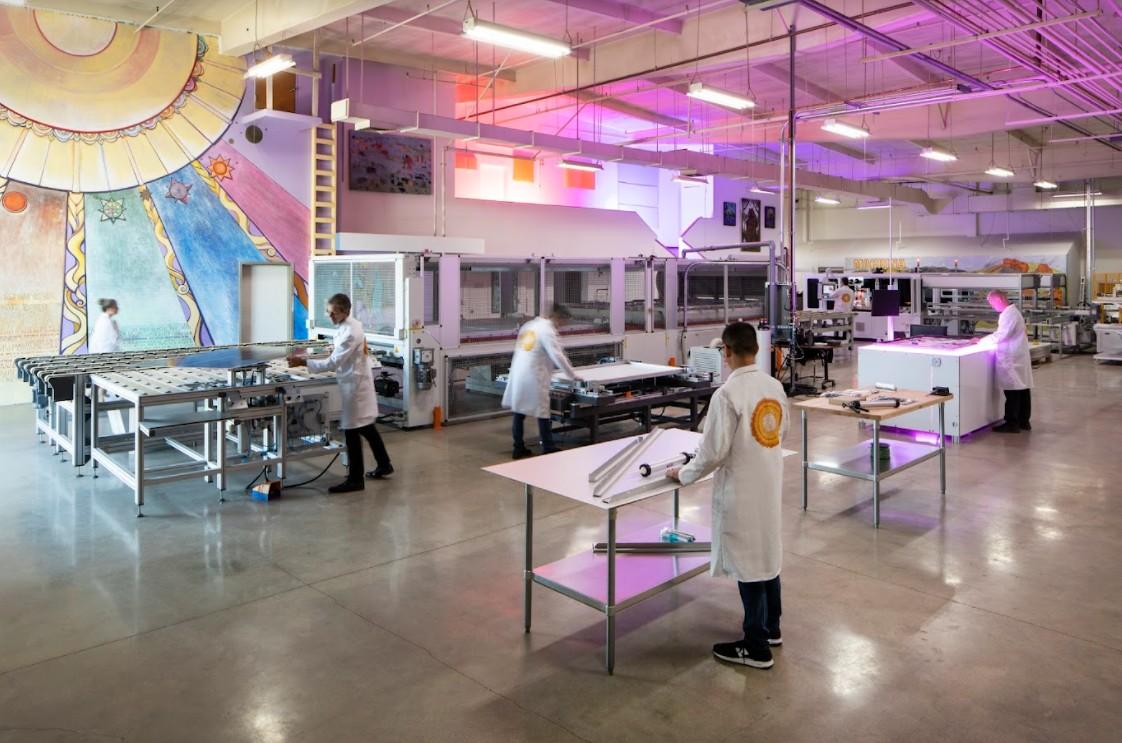
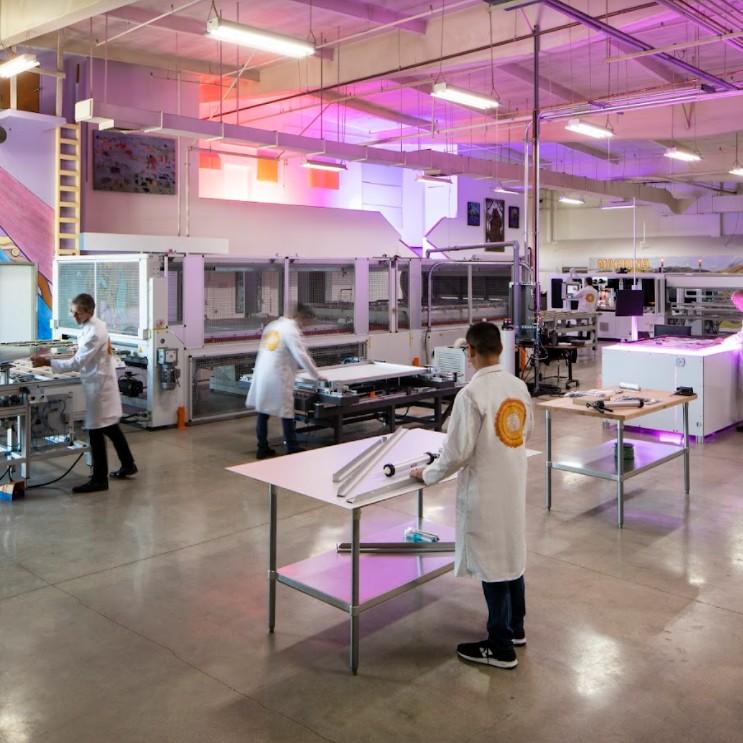
It almost sounds too good to be true — clean, renewable energy that stimulates economic activity in underserved communities across the United States. Add to that, the solar panels being constructed by CHERP Solar Works are some of the most technologically advanced on the market, and — wait for it — they will provide free solar energy to the lowest income households across U.S. communities.
So wait, what’s the catch?
No catch. This nonprofit organization wants to change the traditional relationship between energy providers and energy users. They want to put ownership back in the community’s hands. To do this, they’ve also enlisted the help of Seneca Solar, which has recently worked with Indigenous communities in the U.S. so that they can become owners of their own energy assets.
“We see wealth continuing to be extracted from our lowest household income families to the top 1 percent. We see our environment continuing to degrade at unprecedented rates,” says CHERP President and CEO, Devon Hartman.
CHERP's dream is becoming a reality. It recently opened the world’s first nonprofit solar module assembly factory in the world in Pomona, California.
What is CHERP, and what is the nonprofit doing?
CHERP (Community Home Energy Revolution Project) began with the goal to form collaborative partnerships with cities, counties, community organizations and contractors to promote sustainable building practices and reduce fossil fuel use in buildings throughout California and beyond. Now, CHERP Solar Works is building solar panel factories around the U.S.
“We build micro solar factories for nonprofit organizations in underserved communities across the country,” Hartman explains.
In the age of globalized energy production, CHERP wants to bring it back to basics and work locally. By engaging with communities, hiring local workers, producing energy in the community, and providing energy to local households, CHERP wants its activities to benefit local communities to the greatest extent possible.
The plan is to “keep the entire value chain inside the local community so that profits can be recirculated as many times as possible inside the local economic unit,” Hartman says.
One of CHERP’s plans is to provide free energy to the 6,000 lowest income households near its new assembly factory in Pomona, California. Its research suggests that the low-income households in the area spend $90 per month on energy. Removing this monthly expense will create $6.5 million of additional yearly disposable income in the community.
Advanced solar technology
CHERP is also claiming to make “the safest panels on the market.”
Its patented technology is going to remove the problem of hotspots that plagues almost every solar panel made today. Solar panels attract sunlight, but sometimes that sunlight becomes concentrated in one or two spots on the panel. Those “hotspots” heat up much quicker than the rest of the panel, reducing energy efficiency and also creating a safety hazard and fire risk.
“Hotspots can not only get hot, but they can create plasma arcs that will melt through any material on earth, and we can actually burn buildings to the ground,” Hartman explains.
“Our panels will never create a reverse bias or hotspot condition, but also, they will be the safest panels on the market. They will automatically shut down in a millisecond if they do not sense an inverter so they will not create energy, and they will not kill firefighters who have to go on a building,” Hartman continues.
The entire operation at CHERP is a bit of an energy revolution. The organization also wants to see solar panel production return to the U.S.
American-made solar panels
Solar panel technology was invented in the U.S. back in 1954 by three scientists at Bell Laboratories. Ever since then, production of solar panels has slowly shifted away from the U.S.
“Ninety-four percent of all solar panels distributed in this country right now come from overseas,” Hartman says. The overwhelming market leader in solar panel production is China, which accounts for more than 80 percent of the world’s share in solar panel manufacturing.
China is also well ahead in installed solar capacity: It's expected to add up to 90 gigawatts (GW) of installed solar power in 2022, bringing the country’s total installed capacity to nearly 400 GW. By comparison, the U.S. added 3.9 GW of solar capacity in the first quarter of 2022, bringing its total capacity to 126 GW.
CHERP wants to increase U.S. production of solar technology, increase participation in the economy from underserved communities, and advance solar technology. If its ideas catch on, the nonprofit hopes to build factories throughout the U.S. to benefit local communities.
Image credit via CHERP